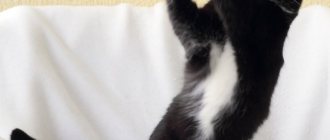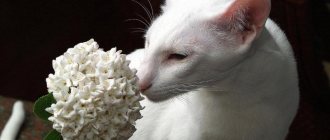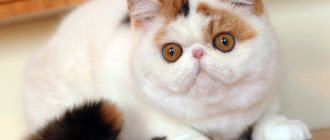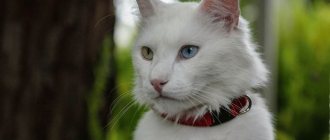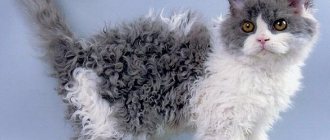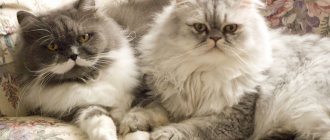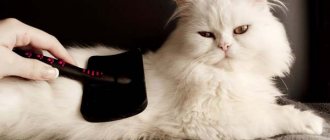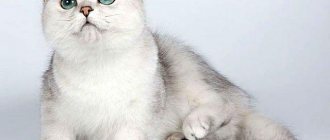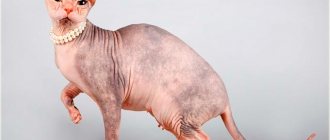Havana Browns are graceful, narrow-faced cats with movable locator ears and fur with a uniform brown tint. Interesting appearance, high intelligence and amazing character make them an object of increased interest among connoisseurs of rare breeds. But before you get a green-eyed beauty in a chocolate fur coat, you should figure out what else is hidden behind the exotic appearance of the Havana Brown.
Brief history of the breed
The Havana Brown breed originated in England. Although the first records of similar cats date back to the 1800s, deliberate selection began in the 1950s. The breeding of the Havana began with the light hand of three breeders - Baroness Miranda von Ullman, Mrs. Fisher and Anne Hargreaves.
To achieve their goal, the women used chocolate and seal point Siamese and black shorthaired domestic cats. At some point, the blood of Russian Blues was added to the mestizos, but its genes are absent from the DNA of modern Havana.
The new breed received official status in 1958. Around the same time, part of the livestock was exported to the United States. Due to problems with genetics, representatives of the English line began to be crossed with cats of other breeds. Because of this, their fur acquired a variety of shades, and they themselves began to be called the chestnut oriental cat. Unlike their British counterparts, American breeders only bred cats with chocolate coats. It was they who received the name “Havana Brown”.
Features of the Havana breed
The Havana cat is very smart and has many positive character traits. Nature has endowed her with amazing endurance. These are real masters of sports who can surprise us with magnificent demonstration performances.
Loneliness is not acceptable for these animals
Communication and a person’s attention is what they strive for, what they want most. This sociable animal will find an approach to any other member of the household.
Aggression and attacks of anger are not inherent in them at all. They are child friendly. They love to curl up in a ball and sleep near their relatives.
The paws of a Havana cat play a big role for her. With their help, she learns everything new around her and communicates with people.
Does she put her paws on a person and meow invitingly? This is a sure sign that she lacks communication and thus attracts attention to herself.
This is a very curious and brave animal. Hearing the slightest movement at the front door, a Havana cat immediately runs to check who has come, while cats of other breeds in a similar situation most often hide in secluded places. They love to play and fool around, but do not create a chaotic mess in the house if they are left alone on the farm.
Some Oriental Havana cats can sit quietly in their owner’s arms or curl up and sleep in a secluded place, while others will happily climb onto a person’s shoulders or get under his feet all the time, getting in the way and constantly meowing. The behavior of Oriental Havanas depends on their temperament, and it is different for everyone.
All they need is attention. Thanks to their sociability, they can easily and for a long time make friends with a dog.
The Havana cat endures travel easily and without difficulty. She does not throw tantrums about this and does not fall into a depressive trance.
But without long-term communication with a person, depression and even illness are possible. Therefore, people who are more on the road than at home are not recommended to have such cats. They love to conquer heights. They lead an active lifestyle until the end of their days.
Breed description, standards, appearance
The Havana Brown is a graceful cat with well-developed muscles and short hair. Visually, it resembles the Siamese, but differs from them in having green eyes, an elongated narrow muzzle, large ears and a uniform brown color.
Dimensions and weight
The Havana is a medium-sized cat with moderate sexual dimorphism. The average weight of a female is 2.5-4 kg. The weight of a male can reach 5 kg.
Anatomical characteristics
According to the first and only true TICA standard, a Havana Brown cat must meet the following description:
- The head is elongated, with a rounded muzzle, pronounced cheekbones, a prominent profile and a protruding chin.
- The eyes are large, expressive, almond-shaped. The Havana iris is bright green. In kittens under one year of age, the color of the eyes may change.
- The cat's ears are set wide and slightly tilted forward. The shells are large, with rounded tips.
- The body is elegant, slender, with developed muscles, strong bones and minimal fat reserves.
- The limbs are proportional, with developed joints. The front legs are slightly shorter than the hind legs, which is why the Havana's croup appears slightly raised. The paws are compact, with pink pads.
- The tail is long, with a pointed tip.
Color and coat type
The Havana is a short-haired cat breed with smooth, glossy, chocolate-colored fur. The animal's coat may have a red-brown or brown-violet tint. The color of the Havana's whiskers should match the color of the coat. The nose is pigmented brown with a pink tint.
On a note. Havana Brown kittens can have a tabby pattern. But by the age of one year, the spots and stripes on their coat completely disappear.
Possible breed defects
Flaws in appearance, in the presence of which the Havana will be disqualified and classified as a representative of the pet class breed:
- creases and curvatures of the tail;
- spots and medallions;
- polydactyly;
- iris color other than green;
- discrepancy between the shade of the mustache, nose and fur;
- not pink paw pads.
Rare breed of Havana cats
Before we start talking about the breed of a cat such as the Havana, let’s be clear right away: the true breed of Havana cat is not available to you, your friends, acquaintances, and even the governors of your region or region you know. Under the guise of this breed you may have: Oriental, Scottish Fold and Scottish Straight, Persian Shorthair, Exotic, Burmese, Devon Rex, British, Abyssinian chocolate-colored cats.
If you have a cat, then it’s a different matter! A Havana cat can “happen” in our country if the owner is willing to pay from 5,000 to 10,000 US dollars for it (depending on the pedigree and class of the cat), but this cat will be unsuitable for breeding due to surgical intervention at the age of 4-6 months . Before this age, no one from the breeding nursery will sell you a kitten: the positive potential before this time is difficult to determine, and if the potential of the future stud cat is determined to be low, then the cat can be sold, having first deprived him of the opportunity to spread his low potential throughout the whole world .
As of 2015, only 123 purebred Havana cats were registered in the world.
It’s simply scary to imagine the cost of this cat! Probably for this reason they are not sold, but are used purely for breeding purposes. Well, and because of the “limited contingent”, of course!
Character and temperament
The Havana Brown is a sociable cat and does not tolerate loneliness well. If an animal is left to its own devices for a long time, it can become depressed and get sick. Unlike many cats, the Havana actively uses its paws. With them she touches objects that interest her and attracts the owner's attention.
The playful and talkative Havana gets along well with children of all ages and gets along well with other pets. She can scratch only through negligence. And if the Havana Brown doesn’t like something, it won’t hiss or release its claws - the cat simply retreats with a loud meow.
Health and immunity
Havana has a strong immune system, but from her Siamese parents she inherited a considerable list of hereditary diseases.
Diseases to which the breed is predisposed:
- Cardiovascular diseases. Most often they manifest themselves as cardiomyopathy.
- Kidney dysfunction. In old age, Havanas are faced with urolithiasis.
- Problems of the lungs and upper respiratory tract.
- Ulcers and inflammations on the mucous membrane of the mouth.
Regular visits to the veterinarian will help reduce the risk of developing hereditary diseases. Proper care and mutual love will help the cat live a happy life of 15 years.
Mutual love will help a cat live a happy life
Video – Havana cat breed
You can learn about life near Havana from the video:
https://youtube.com/watch?v=ey2WndKM2Ko
Havana is an excellent choice for those looking for a furry companion in the form of a purebred cat. The breed needs constant communication, so it is suitable for people who are domestic and love cats. Keeping such a pet will not cause any trouble, and friendship with him will be fun and comfortable.
How to choose the right kitten
Havana Brown is a rare breed, the bulk of whose livestock is concentrated in the United States and Western Europe. Therefore, it is better to look for a purebred kitten in a foreign cattery.
When choosing a potential pet, you should pay attention to the following nuances:
- availability of pedigree and veterinary passport;
- conditions of detention;
- behavior;
- condition of the kitten's eyes, ears, skin and fur.
On a note. A small kitten may not have a “Cuban” appearance and this must be taken into account when purchasing. Spots and stripes are acceptable on the baby Havana's coat, as well as rings on the tail.
Kitten care
The Havana Brown kitten is ready to go to a new home after it turns 3 months old. Therefore, separating a baby from his mother before this age is not only impractical, but also dangerous for his health. By this time, he manages to receive all the necessary vaccinations, gain basic immunity and learn basic hygiene skills.
Before the kitten arrives, it is advisable to purchase everything you need to care for it:
- bowls for water and food;
- tray with filler;
- bed or house;
- grooming tools (toothbrush, combs, etc.);
- hygienic cosmetics (shampoos, lotions for cleaning ears, etc.);
- toys.
To begin with, the kitten is given several days to adapt and get to know the house. And so that it passes without injury, all potentially dangerous things are removed from the Havana baby in advance: indoor plants, detergents, breakable objects and wires. Close windows and balconies, and also check the insides of ovens and washing machines before turning them on.
The kitten is fed on a schedule that depends on its age. At first, the little Havana is given food 5-6 times a day. Gradually, portions are increased and the number of meals is reduced.
Characteristics of the Havana Brown breed
Those who already know and love cats from the Siamese-Oriental group simply cannot help but like the Havana. And everyone will be glad to meet such a chocolate miracle! Oriental and Siamese cats are so devoted to humans that they are even compared to dogs in this regard. Havana is no exception; communication with the owner is simply vital for her. This need for communication can be considered both a plus and a minus.
Havana, of course, will appreciate the attention from household members who surround her with love, but if she considers the owner to be the one who, for the most part, is absent from home, then she may begin to waste away, feel sad and even get sick, not receiving the much-needed attention and love. She wants to be involved in everything you do - whether you're watching TV, cooking dinner in the kitchen, sitting at the computer, or just enjoying a cup of coffee in the morning.
The cat is hyper sociable and sees the world only this way. For her, the most important thing is to be the owner’s constant “tail,” to “help” him (in her understanding, of course), to constantly twirl under his feet, climb onto his knees and crawl under his arm to stroke him. The pet will also explore everything in the house, especially those items that will be of interest to him, and will even restore his own “order” at home.
She wants to be involved in everything you do - whether you're watching TV, cooking dinner in the kitchen, sitting at the computer, or just enjoying a cup of coffee in the morning. The cat is hyper sociable and sees the world only this way. For her, the most important thing is to be the owner’s constant “tail,” to “help” him (in her understanding, of course), to constantly twirl under his feet, climb onto his knees and crawl under his arm to stroke him. The pet will also explore everything in the house, especially those items that will be of interest to him, and will even restore his own “order” at home.
The cat is interested in literally everything - if the owner disassembled, for example, a vacuum cleaner in order to repair it, then the Havana will certainly take care of the spare parts, trying to pay attention to each of them, in full confidence that without her participation the owner will not see success. Accustom this cat to a house, bed, basket, etc.
- an absolutely useless exercise, since the Havana is unshakably confident that its place to sleep is only in the master’s bed, and nothing else. If the owner does not protest or resist at first, then the cat will use its charms so imperceptibly and insidiously that he himself will not notice when he has become as dependent on the pet as the pet is on him.
Fans of this breed who really want to have a Havana in their home, but at the same time realize that they will not be able to give it the proper amount of attention, can be advised, strange as it may sound, to get a cat for their cat. It could be a sister from the same litter or even a kitten of a completely different breed, it doesn't really matter. The main thing is that the Havana can communicate and “talk” with such a friend while the owner is away. Havanas always treat other animals very tolerantly, do not enter into conflicts with them, and can often even sleep in an embrace - regardless of the fact that the other pet can be either a cat or a dog.
All Siamese and Orientals have a love of “talking”, and for them it doesn’t matter at all what time of day it is, or what kind of mood the owner is in. It must be said that the vocal arsenal of these wonderful creatures is extremely rich - they can gently purr, melodiously “sing”, hoarsely scream, and even scream absolutely unmusically
Fortunately, Havana is somewhat less talkative, unlike its eastern “relatives” - it speaks several times less often, and not in such loud and harsh notes.
But curiosity is inherent in this breed no less than in other representatives of the Siamese-Oriental trend. Therefore, even before purchasing a kitten, you should thoroughly prepare and take care to make its life safe. Remove all dangerous and unstable heavy objects away so that they cannot get in the way of a curious baby. Hide everything, valuable and fragile, and place poisonous house plants so that the pet cannot get to them under any circumstances. It is worth keeping in mind the excellent climbing abilities of these cats. This means they will certainly climb curtains, climb cabinets, and generally explore any places that, at first glance, may seem difficult to reach.
Care and maintenance
Havana is an unpretentious cat; he does not need specific conditions. To maintain a neat appearance, it requires minimal hygienic care:
- To make a cat's chocolate coat look aesthetically pleasing, it is regularly treated with a special rubber glove. In normal times, the procedure is carried out once a week. During the molting period, the Havana Brown is combed more often. The cat is bathed once every 2-3 months using special shampoos for short-haired breeds that do not dry out the skin and do not cause allergies.
- To remove plaque and prevent dental diseases, the cat's teeth are brushed three times a week with a soft brush and a small amount of non-foaming paste.
- The Havana's claws are trimmed with a nail clipper as they grow. In this case, only the transparent ends are removed.
- The cat's eyes and ears are regularly inspected for any unusual discharge and cleaned with a moistened cotton swab.
Keeping a chocolate pet
Caring for a Havana is easy. The shorthair cat requires minimal assistance from the owner. The main points will be grooming and diet selection.
Grooming
The Havana breed does not need frequent water treatments. You can bathe your cat as it gets dirty or once every two to three months as a preventive measure. If the animal walks outside, it can be washed more often.
For bathing, it is advisable to use special shampoos for cats. Such products do not provoke allergies and prevent drying of the skin.
If you don’t have cat food on hand, you can use baby shampoo. But you can’t constantly bathe her in “human” shampoo.
Swim again?
Even cats that don't go outside need bathing. Antiparasitic treatment includes washing and wearing a flea collar.
In addition to bathing, the Havana will need periodic brushing. This cat is affectionate, so it tolerates the procedure easily and with pleasure. One approach per week at normal times and twice during shedding is enough. To minimize the amount of hair in the apartment on other days, it is enough to run a rubber-gloved hand along the sides of the cat.
Ears, eyes and teeth
Hygiene procedures are not limited to bathing. Every day it is necessary to inspect the ears, mouth and area around the eyes for contamination.
It is recommended to wipe the corners of your cat's eyes with a damp cotton swab daily. If the cat gets into cobwebs or dust, which leads to watery eyes, you can use warm tea leaves to rinse.
Once every one and a half to two weeks, the cat will have to endure an unpleasant interference in her personal space. It is mandatory to brush your pet's teeth, no matter how much the animal protests. You can read about the rules for cleaning fangs in the relevant articles or consult a veterinarian.
Well-groomed appearance
Claws
Cat's claws are not so much a hygienic problem as an educational one.
To prevent your pet from destroying upholstered furniture and wallpaper, it is important to take care of its manicure
Table 1. Remedies for claw problems
| How to solve a problem | Nuances |
| Nail trimming | The easiest way involves regular manicure sessions. The sharp edge of the claw is cut off with special pliers, after which the cat does not need to tear off the wallpaper. |
| Silicone pads | Special soft attachments covering the sharp part of the claw. They are put on a cut nail and protect the furniture for several weeks, after which they require replacement. |
| scratching post | The most natural way for a cat to file down its claws. The pet must be taught to adapt from an early age, until he chooses another place for sharpening. |
Feeding the cat
To maintain health, the Havana Brown needs a nutritious diet with vitamins and microelements. Many modern breeders advise feeding their pets with high-quality premium or super-premium dry food from trusted global manufacturers. This cat food already contains the balance of substances for the normal functioning of the animal’s body, and the owner does not need to independently think through the menu and calculate the proportions.
Havana Brown cats eat the following brands of food quite well:
- Brit Care;
- Farmina;
- Pronature;
- Monge.
Adherents of natural food recommend giving your cat fresh lean meat, cereals, vegetables and fermented milk. It is advisable to include offal, eggs and ocean fish into the Havana Brown's diet twice a week.
Important! Cats of this breed are prohibited from giving fatty meat, river fish, smoked meats, pickles, sausages, sweets, baked goods and any food from the master's table.
Catering
The health of your pet and its appearance depend primarily on the proper organization of its diet. The Havana is unpretentious in its choice of food, but breeders recommend feeding it with specialized super-premium food, since it does not contain artificial flavors or flavors. At the same time, you should not get carried away with dry food. It is best to buy food in the form of wet canned food. When choosing natural food, it is important to follow the rule: meat products must contain at least 70%.
What food did you choose for your cat? Store feed
Recommended food
Below are recommended super-premium products, links with product names are clickable. Using them, you can read the description of the food on our website and read reviews from owners of Havana Brown cats.
| Holistic | Premium | Super premium |
| Gina elite | DailyCat | Arden Grange |
The pet will also need clean drinking water, which the cat often likes to take out of the bowl with both paws at the same time.
Expert opinion Vera Ivanovna Dusheba In 2010, she graduated with honors from Leningrad Technical University named after. K.I. Scriabin, veterinarian by specialty. I regularly participate in veterinary conferences, conventions, and webinars. Sterilized animals need control from the owner: due to the needs of the body, they are prone to overeating. Therefore, the solution is to count calories and have a clear feeding schedule.
Education and physical activity
Havana Browns are moderately temperamental and active cats. They love to climb to high places and watch what is happening from there. Therefore, Havanas need special sports corners with various platforms and ladders on which they can climb and jump.
Cats of this breed are distinguished by a high level of intelligence and good memory. They are easy to train and quickly get used to a certain routine. To train a cat, you just need to communicate with it and give commands in a confident voice.
How much does it cost and where to buy
There are just over a hundred purebred Havanas in the world, so the price of a purebred cat is quite high. Depending on the pedigree, it reaches $2,000.
Catteries that offer Havana Brown kittens can be found in the USA and Europe. In Russia, Ukraine and Belarus, there are only nurseries where Siamese and Oriental kittens are bred.
Havana kittens begin to be sold when they reach 4-5 months. By this age, the characteristics of the breed appear. Cats are rarely sold due to their limited number and the need to produce offspring.
Vaccinations and antiparasitic treatment
To prevent infectious and viral diseases, Havana Browns are regularly vaccinated. The first vaccination against calcivirosis, rhinotracheitis and panleukopenia is given to a kitten at the age of 7-8 weeks.
After 28 days, the baby is vaccinated against the same diseases and against rabies. In the future, Havana Brown is vaccinated once a year.
Twice a year, a cat of this breed is given anthelmintic drugs. The dose of the drug is calculated taking into account the body weight of the animal. To combat fleas, special shampoos, drops and anti-parasitic collars are used.
Pros and cons of the breed
By analogy with cats of other breeds, the Havana Brown has both advantages and disadvantages:
| pros | Minuses |
| Interesting exterior | Intolerance of loneliness |
| Low maintenance | Rarity of the breed |
| High intelligence |
Havana Brown is a beautiful cat with a sophisticated appearance, a rare chocolate color and a good-natured, sociable disposition. She easily makes contact with people and will be an excellent companion to someone who surrounds her with attention and care.
Interesting Facts
You can tell a lot of interesting things about this breed. Here are some fun facts:
- Havanas are suitable for people prone to allergies to cat hair. Due to the short coat and rare shedding, there will be no health problems.
- Oriental cats are widely called “rainbow”. This is because they come in multiple colors.
- Due to the lack of undercoat, cats cannot tolerate low air temperatures. Therefore, they must be protected from drafts and not allowed outside in winter.
- With good care they can live up to 20 years. Because of this, they are considered to be long-livers.
- They are remarkable for drinking water from a bowl. Sometimes they start scooping it up with their paw and bringing it to their mouth.
- In the absence of attention from the owner, they begin to meow loudly and show their displeasure in every possible way.
- Sometimes Havanas get jealous. This applies not only to family members, but also to a specific place or object.
- Cross-eyed Havanas are sometimes found. Such a phenomenon is not acceptable according to the standard and is listed as a defect.
- Havana cats rarely use their claws. Therefore, they will be the best friends for children.
- There is a version that Havanas are telepaths - their intuition and sensitivity are so highly developed, which is unusual for other representatives of the cat family.
- They often begin to copy the behavior of their owner. Therefore, many cats begin to go to the toilet in a human way - on the toilet.
